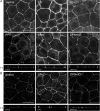Oestradiol decreases colonic permeability through oestrogen receptor beta-mediated up-regulation of occludin and junctional adhesion molecule-A in epithelial cells
- PMID: 19433574
- PMCID: PMC2727039
- DOI: 10.1113/jphysiol.2009.169300
Oestradiol decreases colonic permeability through oestrogen receptor beta-mediated up-regulation of occludin and junctional adhesion molecule-A in epithelial cells
Abstract
Oestradiol modulates paracellular permeability and tight junction (TJ) function in endothelia and reproductive tissues, but whether the ovarian hormones and cycle affect the paracellular pathway in the intestinal epithelium remains unclear. Oestrogen receptors (ERs) are expressed in intestinal epithelial cells, and oestradiol regulates epithelium formation. We examined the effects of oestrous cycle stage, oestradiol benzoate (EB), and progesterone (P) on colonic paracellular permeability (CPP) in the female rat, and whether EB affects expression of the TJ proteins in the rat colon and the human colon cell line Caco-2. In cyclic rats, CPP was determined through lumen-to-blood (51)Cr-labelled EDTA clearance, and in Ussing chambers for dextran permeability. CPP was also examined in ovariectomized (OVX) rats treated with P or EB, with and without the ER antagonist ICI 182,780, or with the selective agonists for ER beta (propyl pyrazole triol; PPT) or ER beta (diarylpropionitrile; DPN). In oestrus rats, CPP was reduced (P < 0.01) relative to dioestrus. In OVX rats, EB dose-dependently decreased CPP, an effect mimicked by DPN and blocked by ICI 182,780, whereas P had no effect. Oestradiol increased occludin mRNA and protein in the colon (P < 0.05), but not zona occludens (ZO)-1. Further, EB and DPN enhanced occludin and junctional adhesion molecule (JAM)-A expression in Caco-2 cells without change in ZO-1, an effect blocked by ICI 182,780. These data show that oestrogen reinforces intestinal epithelial barrier through ER beta-mediated up-regulation of the transmembrane proteins occludin and JAM-A determining paracellular spaces. These findings highlight the importance of the ER beta pathway in the control of colonic paracellular transport and mucosal homeostasis.
Figures






Similar articles
-
Neutrophil transmigration in inflammatory bowel disease is associated with differential expression of epithelial intercellular junction proteins.Am J Pathol. 2001 Dec;159(6):2001-9. doi: 10.1016/S0002-9440(10)63051-9. Am J Pathol. 2001. PMID: 11733350 Free PMC article.
-
Impact of oral bisphenol A at reference doses on intestinal barrier function and sex differences after perinatal exposure in rats.Proc Natl Acad Sci U S A. 2010 Jan 5;107(1):448-53. doi: 10.1073/pnas.0907697107. Epub 2009 Dec 14. Proc Natl Acad Sci U S A. 2010. PMID: 20018722 Free PMC article.
-
Interaction of junctional adhesion molecule with the tight junction components ZO-1, cingulin, and occludin.J Biol Chem. 2000 Jul 7;275(27):20520-6. doi: 10.1074/jbc.M905251199. J Biol Chem. 2000. PMID: 10877843
-
The roles of claudin superfamily proteins in paracellular transport.Traffic. 2001 Feb;2(2):93-8. doi: 10.1034/j.1600-0854.2001.020203.x. Traffic. 2001. PMID: 11247307 Review.
-
Structural determinants of Junctional Adhesion Molecule A (JAM-A) function and mechanisms of intracellular signaling.Curr Opin Cell Biol. 2009 Oct;21(5):701-7. doi: 10.1016/j.ceb.2009.06.005. Epub 2009 Jul 14. Curr Opin Cell Biol. 2009. PMID: 19608396 Free PMC article. Review.
Cited by
-
Sex Differences in Colon Cancer: Genomic and Nongenomic Signalling of Oestrogen.Genes (Basel). 2023 Dec 16;14(12):2225. doi: 10.3390/genes14122225. Genes (Basel). 2023. PMID: 38137047 Free PMC article. Review.
-
Mechanisms of Visceral Organ Crosstalk: Importance of Alterations in Permeability in Rodent Models.J Urol. 2015 Sep;194(3):804-11. doi: 10.1016/j.juro.2015.02.2944. Epub 2015 Mar 14. J Urol. 2015. PMID: 25776913 Free PMC article.
-
Sex, Microbes, and Polycystic Ovary Syndrome.Trends Endocrinol Metab. 2019 Jan;30(1):54-65. doi: 10.1016/j.tem.2018.11.001. Epub 2018 Nov 29. Trends Endocrinol Metab. 2019. PMID: 30503354 Free PMC article. Review.
-
Proteomic Assessment of iTRAQ-Based NaoMaiTong in the Treatment of Ischemic Stroke in Rats.Evid Based Complement Alternat Med. 2019 May 15;2019:5107198. doi: 10.1155/2019/5107198. eCollection 2019. Evid Based Complement Alternat Med. 2019. PMID: 31223330 Free PMC article.
-
Therapeutic potential of flavonoids in inflammatory bowel disease: A comprehensive review.World J Gastroenterol. 2017 Jul 28;23(28):5097-5114. doi: 10.3748/wjg.v23.i28.5097. World J Gastroenterol. 2017. PMID: 28811706 Free PMC article. Review.
References
-
- Ait-Belgnaoui A, Bradesi S, Fioramonti J, Theodorou V, Bueno L. Acute stress-induced hypersensitivity to colonic distension depends upon increase in paracellular permeability: role of myosin light chain kinase. Pain. 2005;113:141–147. - PubMed
-
- Amasheh S, Milatz S, Krug SM, Bergs M, Amasheh M, Schulzke JD, Fromm M. Na+ absorption defends from paracellular back-leakage by claudin-8 upregulation. Biochem Biophys Res Commun. 2009;378:45–50. - PubMed
-
- Artis D. Epithelial-cell recognition of commensal bacteria and maintenance of immune homeostasis in the gut. Nat Rev Immunol. 2008;8:411–420. - PubMed
-
- Bazzoni G, Martinez-Estrada OM, Orsenigo F, Cordenonsi M, Citi S, Dejana E. J Biol Chem. 2000;275:20520–20526. - PubMed
-
- Campbell-Thompson M, Lynch IJ, Bhardwaj B. Expression of estrogen receptor (ER) subtypes and ERβ isoforms in colon cancer. Cancer Res. 2001;61:632–640. - PubMed
Publication types
MeSH terms
Substances
LinkOut - more resources
Full Text Sources
Medical
Miscellaneous

